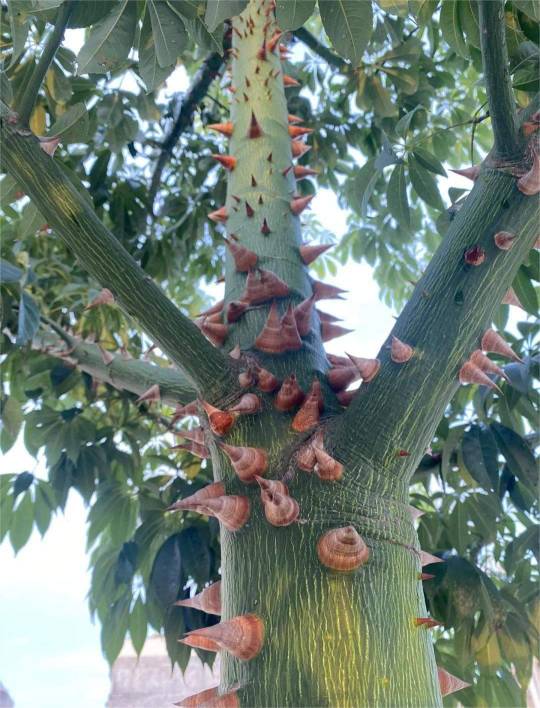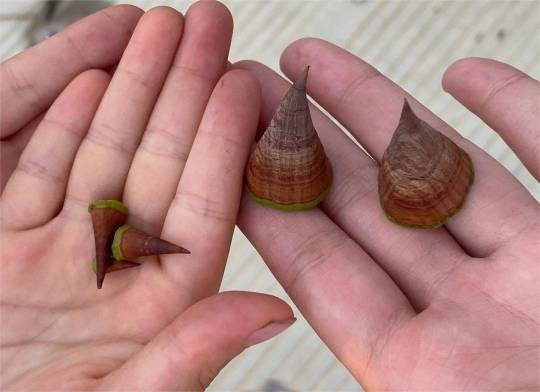#Ceiba pentandra
Text
"Sunlight dapples the once-denuded forest floor as saplings spread their branches and leaves overhead, slowly forming a lush canopy.
Beside each young tree, a sign notes its species. Lupuna, says one, the colloquial Peruvian term, and below that its scientific name, Ceiba pentandra — in other words, a kapok tree, known for its cotton-like fibers. Huito, says another sign, or Geinpa americana, which produces edible gray berries.
Each sapling is distinct, a reflection of the Amazon's stunning biodiversity, with so many different species that you might go acres without finding a repeat.
Yet this young forest did not spring up naturally. It has been carefully recreated by humans in an area that was, until just three years ago, a heavily contaminated moonscape.
This land was stripped of its dense vegetation by miners scouring the subsoil for tiny specks of gold, using mercury to separate the gold from the sediment. Many thought that a healthy forest would never thrive in impoverished, mercury-laden topsoil and that the piles of sandy tailings, the residue from the gold mining effort, and the pools of wastewater were irremediable...
"It feels good to see the forest grow back," says Pedro Ynfantes, 66, the miner whose legal mining concession of 1,110 acres includes this 10-acre patch of land where this young forest is located. "We don't want to deforest. When we had the opportunity to let the forest grow back, we took it. It's much better this way."
The opportunity he refers to came via U.S. nonprofit Pure Earth, which works with communities across the Global Southto remediate environmental problems left behind by mining, much of it illegal. Their biggest targets are mercury and lead contamination...
Security forces have launched anti-mining operations down the years, even blowing up the miners' equipment deep in the jungle. But most local politicians, including Madre de Dios' members of Peru's national congress, broadly support the miners, who are a powerful constituency in the relatively sparsely populated jungle region.
Restoring the forest
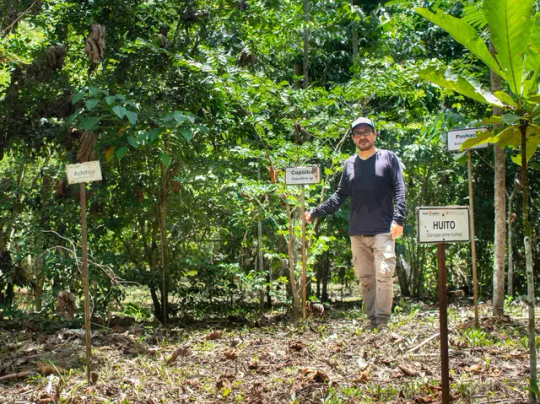
Pictured: France Cabanillas works for the nonprofit group Pure Earth, which is spearheading an effort to plant saplings in areas of the Peruvian Amazon that were devastated by illegal gold mining.
Now there's an effort to address the damage. Initially working with the region's legal miners, most of whom were here before the 2009 gold rush kicked off, the nonprofit group Pure Earth is using this patch of Ynfantes' land as a pilot project to show how the rainforest can be regenerated after the last traces of gold have been plucked from the soil.
It took a sustained outreach effort. Many miners are wary of or even downright hostile to foreign NGOs, which have repeatedly called for gold mining to be banned or severely curbed in the Peruvian Amazon — steps they say would cost them their livelihood.
"I am feeling optimistic," says France Cabanillas, Pure Earth's local coordinator, who has been appealing to the frustration of many miners at the heavy toll they have taken on the jungle and their desire to minimize their environmental footprint for the next generation.
"We still have a lot to do but this pilot is going well. Down the years, the miners have been getting a lot of stick but not much carrot when it comes to their environmental impacts," says Cabanillas. "We are offering them a carrot, allowing them to remediate their own impacts. Many of the miners do not want to be destroying the rainforest."
Before the miners plant the carefully-selected mix of tree species, they had to prepare the earth. Most of the topsoil had been washed away by the miners' heavy use of hoses.
That preparation involved adding biochar (burnt organic material) and even molasses, which contain fixed carbon and minerals, along with various other nutrients. The miners also had to dig tiny moats around the saplings to prevent all of this new planting from being washed away. Now, after three years, the forest is visibly coming back.
The rejuvenated rainforest also mitigates the impact of the mercury used by many of the illegal miners.
Research done by Pure Earth shows that the barren, sandy soil emits mercury. But in a rainforest, the ecosystem actually absorbs some of the metal, boosting public health."
-via NPR, April 2, 2024
#mining#illegal miners#gold#gold mining#peru#rainforest#ecosystem#mercury#environment#pollution#remediation#reforestation#good news#hope
359 notes
·
View notes
Photo




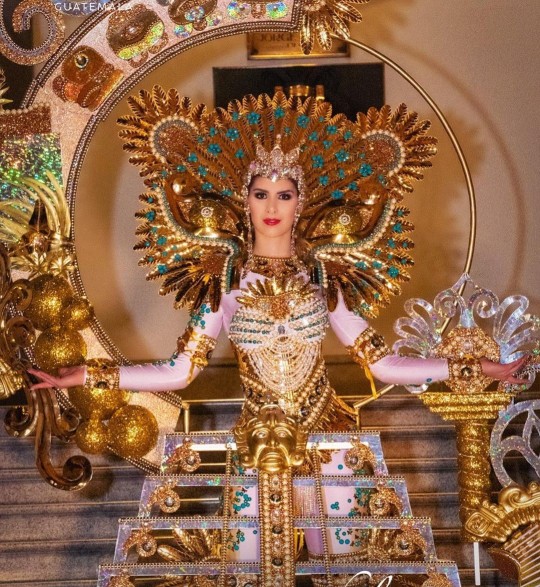


Miss Universe Guatemala 2022 National Costume:"Immortal Guatemala - Jaguar of the Americas"
Showing the world the beauty of Guatemala, a country that has 3 thousand years of cultural wealth In the framework of the National Palace of Culture, which is identified as the symbol of the City of Guatemala and the country in its architectural context monumental. This stage allowed our National Queen to be photographed in the Flags, Banquets halls and in the main stands of the compound. The suit is a representation of iconic elements of the country, the Mayan calendar, the pyramid of "The Great Jaguar," the jade. It has a back where the face of the jaguar is highlighted, the universal symbol of Mayan culture. Traveling in time, and with the colonization of Spain, highlight Solomonic columns that adorn the outfit, highlights the national flower "Monja Blanca", surrounded by leaves of the national tree, the "Ceiba Pentandra". Within modern art stands one of the most important works of the artist Efrain Recinos, the National Theater of Guatemala. It includes the marimba, which adorns the bottom right of an outfit that celebrates the richness and splendor of an immortal Guatemala. The suit is complemented by a carpet that represents the Lenten fervor of Guatemala at the Mayor Week, which was recently declared “Intangible Cultural Heritage of Humanity” by UNESCO.
#miss universe#miss universe guatemala#miss universe 2022#national costume#national costume contest#pageant
465 notes
·
View notes
Text

Дерево Сейба (Ceiba pentandra) http://dlvr.it/Swfdg3
22 notes
·
View notes
Text
Sanctuary of the Unseen Forest is a large-scale video installation that creates a moment of awe, felt, when we embrace the presence of a majestic being, a giant Ceiba pentandra from the Colombian Amazon. The artwork becomes a sanctuary, a place to reflect and contemplate our place within the wider systems of nature. Plants are alive, yet they do not present us with the same impression of life that animals do. Are we, as the victims of plant blindness, simply unable to notice their liveliness, or are they so different from us that we have to invent new ways of seeing and apprehending them?
Radical Botany – N. Meeker, A. Szabari
2 notes
·
View notes
Text
27.-29.10.2023
Worum's geht: Die ersten Nächte auf meinem 6-Tages-Trip im Dschungel ("Softcore Amazonas"), Poledancers & bush negros

Habe die erste soweit geruhsame Nacht am Rande des Dschungels hinter mir, nachdem wir gestern von Atjonie fünf Stunden den Suriname River stromaufwärts gefahren sind, und zwar fast ohne Pause (eine Ausnahme bei der wir wegen des Wasserstands aussteigen und laufen mussten). Mir tat, gelinde gesagt, der Arsch weh. Die Sitzbank in dem dachlosen Taxiboot besteht aus einer einfachen Holzplanke und der Motor brummt unangenehm durch den ganzen Bauch.
Wir sind in einem schönen Lodge in dem schwarzen Dorf Goejaba untergebracht; der Flair ist hipp aber einfach, Strom zum Handyladen sporadisch verfügbar und die einzigen Gäste sind junge modisch tätowierte Damen in bunten Strandtüchern, die mit ihren Tourguides kichernd baden gehen. Später werde ich mich bei dieser Erinnerung etwas angeekelt schütteln, denn da schwamm noch ordentlich viel Müll im Fluss; kein Vergleich zu dem trinkbaren Wasser am Sintiadam.
Meine Lodge-Nachbarn in Goejaba sind drei Surinamesen aus Paramaribo, die für das Wochenende ausspannen. Ich komme kurz mit ihnen ins Gespräch. Kevin, einer der drei, ist hocherfreut, als ich ihm von meinem IT-Job erzähle. Er selbst habe gerade seinen Abschluss in Informatik gemacht. Ich: "Really? I would not have guessed!" Warum ich das sage? Weil Kevin nicht dem Stereotypen des Informatikers entspricht. Er erinnert mich an die Theaterstudenten aus meiner Unizeit, allein von der körperbewussten Art, wie er sich bewegt, und von den kunstvollen Tattoos auf der nackten Brust. Kevin zuckt mit den Schultern, er nimmt mir meinen Kommentar nicht übel, da habe ich nicht Unrecht, meint er. Seine Reisebegleiterin (und Trainerin), die sich über das Geländer der Terrasse beugt, sagt, dass sie eine Truppe von Poledancers seien. Es dauert nicht lang, da zeigen sie mir verblüffende Videos ihrer Choreografien. Die Dame hat ihre eigene Tanzschule aufgemacht, obwohl der Stangentanz (noch) keinen guten Ruf in ihrem Heimatland genießt. Siehe Insta-Video unten (eventuell nur sichtbar mit Instagram-Konto).
instagram
Unsere Reisegruppe ist alles andere als sexy. Sie besteht aus mir, zwei jungen niederländischen Brüdern, die die meiste Zeit über ihre eigenen Füße stolpern, weil sie den Blick vom Handy nicht heben können, und Sensi, unserem gemütlichen und logistisch leider völlig untalentierten Buschmann und Tourguide. Morgen stoßen dann noch die Bootsmänner Hesti und Freddy hinzu. Am Ende der Reise werde ich erfahren, dass Sensi und ich wohl die einzigen waren, die so etwas wie Seife zum Waschen benutzt haben.
Sensi fühlt sich im Regenwald merklich wohler als in der Logistik. Ich erlebe ihn in der Zivilisation als hektischen Mann, der bei der An- und Abfahrt im Hafen von Atjonie umkehren muss, weil er etwas vergessen hat einzupacken, oder der entgegen der persönlichen Planung plötzlich kein Eis für die Kühlbox (die 6 Tage lang halten muss!) auftreiben kann und auf der Autofahrt zum Hafen dreimal anhält, schließlich bei Familie/Freunden. Sogar das eigene Mittagessen vergisst er, also zeige ich Erbarmen und teile meins mit ihm. Ich erzähle dies mit aller Zuneigung und dem Respekt, der ihm für seine Leidenschaft gebührt, denn er ist ein ganz hervorragender und menschlicher Führer, der für seine KundInnen auch bereitwillig die Extrameile geht. Die kleinen Diskrepanzen haben das Dschungelerlebnis in keiner Weise geschmälert, sondern mir eher gezeigt, unter welcher Arbeitslast ein Freelancer wie er steht.
Ab dem dritten Tag, als wir das letzte Dorf hinter uns gelassen haben und nur noch Regenwald vor uns liegt, fällt die letzte Hektik von Sensi ab und er wird der stille Meister mit der Machete.

Pic: Sensei Sensi sensing the wild.
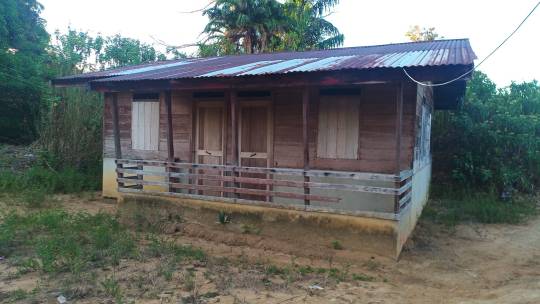

Pic: Das Periodenhaus für die menstruierende Frau. In dieser Zeit darf sie nicht für die Gemeinde kochen. Fast wie Urlaub.
Pic 2: Der Ceiba pentandra - ein heiliger Baum, unter dem sich die Hütten der Saramaccaner ducken.
Aber eins nach dem andern. Auch die zweite Nacht verbringen wir noch unter den Saramaccanern (einer der großen Afro-Stämme Surinams) und genießen den "Luxus" einfacher Holzhütten mit der unzuverlässigen Strom- und Wasserversorgung doch dafür mit der köstlichen surinamesischen Küche aus Fisch, Kassava und verschiedenen Soßen und Suppen. Aber keine Sorge, brummt Sensi und ein Grinsen stiehlt sich langsam auf seine Lippen, das werde sich am dritten Tag ändern. "Then you will have to work, guys. On the third day we will have left the last village behind. After that we are in the wild."
Wenn ich nach diesen sechs Tagen feststelle, dass mich der Dschungel nicht in die Knie gezwungen hat, könne ich darüber nachdenken, auf eine seiner mehrwöchigen Expeditionen in unerschlossenes Terrain mitzugehen. Die Sintiadam-Tour ist ein Amazonas-Training in ultrasoft. Nicht ganz so weichgespült wie die Resort-Touristen, sagt er ganz barmherzig. Doch im Vergleich zu einer Expedition noch Pipifax. Später, als wir im Dschungel am Lagerfeuer, das in dieser Hitze niemals richtig ausgeht, sitzen, wird er uns von den deutschen Bundeswehrlern erzählen, die bei ihm Survival-Trips in entlegene Gebiete machen, oder von einem der größten Geflügelfleischproduzenten Deutschlands, mit dem er fast jährlich in den Amazonas verschwindet, zuletzt zum über 100 Jahre alten Grab des niederländischen Kartografen Johan Eilerts de Haan.
Sensi ist selbst Saramaccaner und hat in fast jedem Dorf dieser Ecke Verwandte. Am zweiten Abend nächtigen wir in Kosindo/Kajana, in dem gerade der Tod eines Gemeindemitglieds betrauert wird, und zwar ganz nach irischer Art: mit Musik und Alkohol. Auch eine zu Ehren des Toten bemalte Fahne wird durch das Dorf getragen und es bildet sich eine lange, jubelnde Schlange, die durch die unbefestigten Straßen zieht. Wir sollen, so Sensi, es lieber unterlassen Fotos von den bunt bekleideten Einwohnern zu machen; Auf der anderen Seite halten grölende Halbstarke uns ihr Smartphone ins Gesicht und filmen uns wie die Affen im Zoo. Nun ja, unser Tourguide besucht an dem Abend noch seine Großmutter im Nachbardorf. Ich frage ihn, ob er Geschwister habe. Er gibt eine lange Antwort. Unterm Strich: Er hat viele Halbgeschwister. Aber die "bush negros", wie er sich selbst bezeichnet, leben selten monogam.

2 notes
·
View notes
Photo

These ceiba trees (Ceiba pentandra). called the kapok or silk-cotton tree in English, were seen on the eastern slope of Cerro Jaboncillo near Portoviejo, Ecuador. In South America the tree plays a role in pre-Hispanic mythologies.
2 notes
·
View notes
Text
Day 24 - The Peruvian Amazon
We head to the dining room for coffee before we start our boat trip. Neither of us slept very well - not really on account of the animal noises surrounding us but because my cough is getting worse, plus the bedsheets were damp because of the humidity. Today we are going to the Macaw clay lick. We take the boat 90 mins upstream and pull up to a “beach” alongside a bunch of other boats. We sit on our stools waiting for the parrots to arrive. There are some birds flying overhead an in the trees but it’s a slow morning - Marco assures us that as long as it doesn’t rain they will come. In the meantime we learn a bit about the different macaws, parrots and parakeets we can see). After a while we go back to the boat and have some breakfast that was packed for us - a boiled egg in a brioche bun (a little strange but it fills a hole).

Not long after starting breakfast the birds start to come. We finish up and bring our stools back up the beach to watch. The birds are quite far across the river from where we are but we can see them through Marco’s telescope. He explains to us that the birds come here for two reasons 1) to get minerals from the clay and 2) to find a mate (parrots stay in couples and are monogamous).
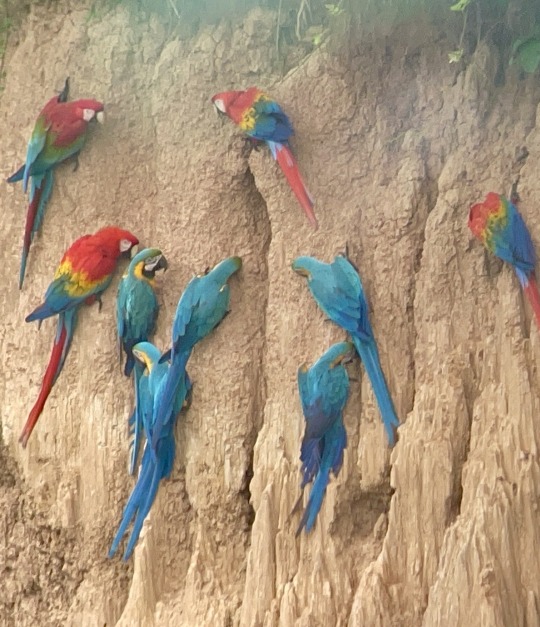
Apparently there were some other clay licks in the region bit as the clay cliffs have moved further from the riverbank vegetation has grown over them meaning that the parrots no longer visit. Marco says this is the case for Collpa Colorado and Collpa Chunchos hence today we are at Collpa Ocho Gallinas (although on Google maps it is marked as Collpa Chunchos). This is one of the last remaining so they need to keep it clear of vegetation to prevent this from happening.
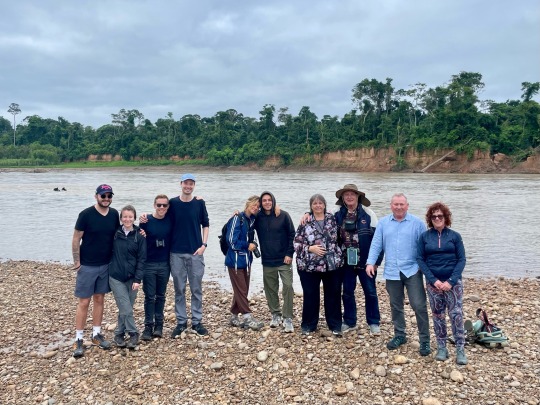
Next we jump back on the boat and go down a smaller channel to try and spot other wildlife. We find several families of Capybara (Jack was very happy about this), a caiman and lots of turtles.
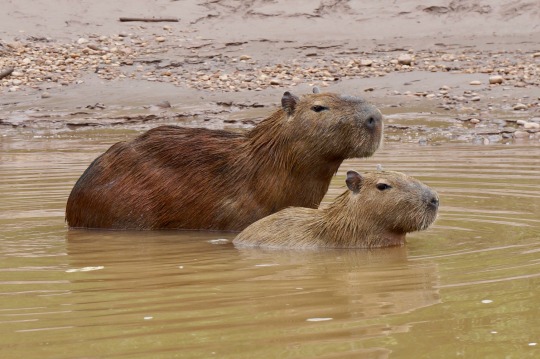

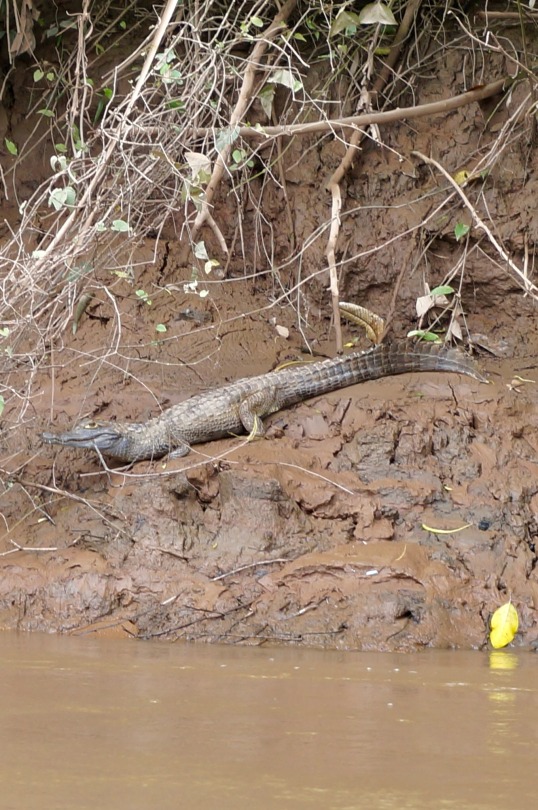
Time to take the boat back to the lodge - we need a nap. We manage to sleep better as we are so tired but I also start getting a fever - I’m wrapped up in blankets despite it being hot.
At 1pm we head into the dining room for our lunch - it’s Aji de Gallina (the dish I had in Cusco).
I’m dosed up on meds so feeling a bit better, there is just enough time to use the wifi before we go on the 3pm hike.
The hike is not very far and we are continually stopping to see stuff. Some things that we encounter are a tarantula’s nest (Marco tries to entice it out by simulating pray with a vine but it doesn’t fool for it) and learn some more about the trees in the area. One tree has a fruit (Jagua) that’s juice can be used as tattoo ink - a few volunteers come forward and Marco applies it directly with his machete - it goes on clear but apparently will go black later and will last 1-2 weeks. The Ceiba Pentandra (kapok) tree rather than having fruits produces a cotton like seed that floats away from the tree.
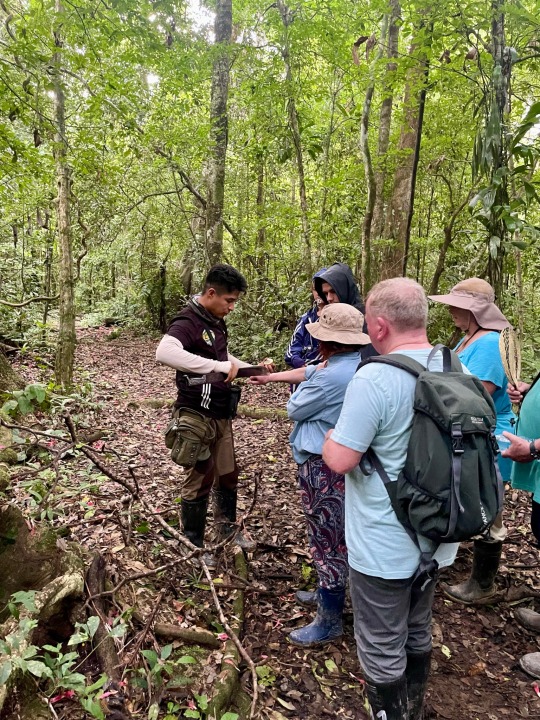
At various points most of the group have been dressed down by Marco for talking too much or asking a question if it’s already been answered. He’s very friendly but at the same time he won’t hold back if he gets frustrated 😂
We also learn a bit more about the timber trade - we see another beautiful Ceiba Pentandra tree which is about 50 meters high and is the tree where the king vultures were perched that we spotted from the tower yesterday. The base of the trees trunk reminds me of a fig. Unfortunately these trees are logged for making plywood. Marco explains that the Chunchos land under its original owner was used to log mahogany and cedar to the point that these trees cannot be found here anymore. Plus planting of rubber trees and harvesting of latex for the car industry.
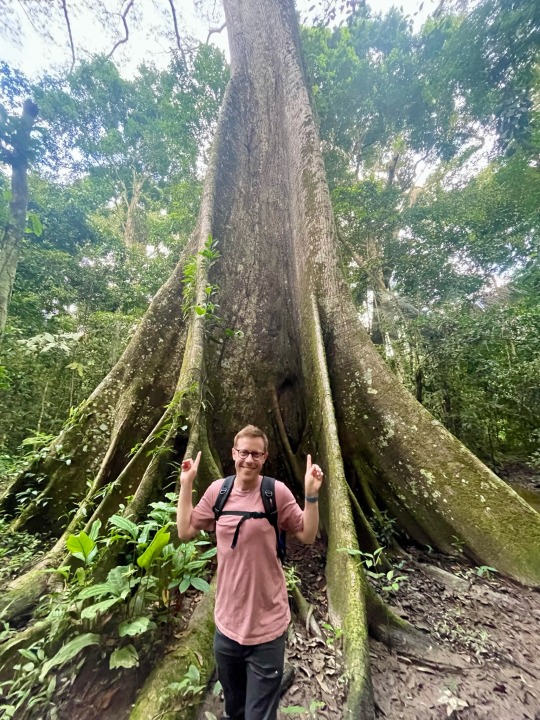
We also stop at an Ironwood (Shihuahuaco) tree. This hardwood is good for building houses hence why it is a target for loggers. Shockingly it is also commonly used for charcoal packets in Europe - what a waste!! Apparently the government will protect this tree within 18months. The Brazil Nut also a target for its timber has already been protected.
These trees are near the property’s boundary and if they were outside they would have already been cut down for sure.
We head back to the hotel via the shortcut route which I am glad about as I’ve been struggling on this walk.
When we get back Marco offers to take us back out in another hour for a night walk and I’d love to go but we decide to stay home as I’m feeling so exhausted.
For dinner we have spag bol and end up staying talking to our group until nearly 10pm. By the time I get up from the table and walk back to the room I suddenly realise how ill I feel - I am completely wiped out, my body is aching. It’s time for bed but I cannot sleep as I am coughing so much and my fever is back throughout night.
0 notes
Text
Museu do Jardim Botânico destaca papel da ciência ante crise ecológica
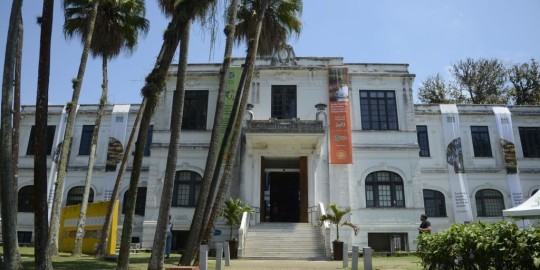
O Jardim Botânico do Rio de Janeiro (JBRJ) abre nesta sexta-feira (8), às 10h, um novo espaço cultural, com entrada gratuita para o público e classificação livre. Trata-se do Museu do Jardim Botânico, que funcionará no casarão do início do século 20, com entrada pela Rua Jardim Botânico, 1008, no bairro do mesmo nome, e que recebeu investimento de R$ 12 milhões da Shell para revitalização.
O Instituto de Desenvolvimento e Gestão (IDG) será responsável pela gestão do museu, que funcionará de quinta a terça-feira, das 10h às 17h, com a última entrada às 16h. Os ingressos podem ser retirados pelo site Botanical Garden RJ - Tickets. O museu conta com 14 salas no total, sendo 12 expositivas.
O presidente do Jardim Botânico, Sérgio Besserman, disse nesta terça-feira (5) à Agência Brasil que o novo museu mostra a ciência que a instituição faz, “a importância da ciência feita no JB para conservação e restauração da natureza do Brasil, das florestas principalmente, de todos os biomas; e também um pouco da história do Jardim”.
Fundado em 13 de junho de 1808, o JB surgiu de decisão do então príncipe regente português, D. João de Bragança, de instalar no local uma fábrica de pólvora e um jardim para aclimatação de espécies vegetais originárias de outras partes do mundo. Atualmente é o Instituto de Pesquisas Jardim Botânico do Rio de Janeiro, órgão federal vinculado ao Ministério do Meio Ambiente e considerado um dos mais importantes centros de pesquisa mundiais nas áreas de botânica e conservação da biodiversidade.
Relevância
Besserman informou que não se mostrará somente o ferramental tecnológico, mas também a relevância da ciência para enfrentar a crise ecológica e apoiar o combate à crise de biodiversidade no Brasil. “Há uma participação muito intensa dos cientistas do JB. Cada peça das exposições permanentes de cada sala, tudo foi feito com participação muito direta e intensa dos próprios cientistas do equipamento, junto com a museologia do IDG”.
Segundo Besseraman, o novo museu reforça o lema do Jardim Botânico: “Muito mais que um jardim: ciência, ensino e história”.
As políticas públicas e ações assertivas desenvolvidas pelo JB para conhecimento e conservação da flora brasileira ao longo de mais de 200 anos de história serão compartilhadas com o público, revelando detalhes das expedições de campo, do trabalho dos botânicos, da pesquisa científica aplicada à conservação da biodiversidade e as atividades dos laboratórios.
“Há salas mostrando pesquisas avançadas de biologia molecular para identificar origem e até localização de madeira, o que ajuda a combater o desmatamento ilegal”, acrescentou Besserman. Além das exposições permanentes, o museu terá conteúdos interativos e ampla programação educativa e cultural.
Logo na entrada do museu, os visitantes conhecerão uma exposição de longa duração, concebida em colaboração com um comitê de funcionários e pesquisadores do Jardim Botânico, que traz a essência do novo equipamento cultural e científico por meio de mais de dez experiências.
Um dos destaques é a obra Sumaúma: Copa, Casa, Cosmos, filme de Estevão Ciavatta, com narração de Regina Casé, que promove uma imersão virtual na sumaúma (Ceiba pentandra), árvore amazônica presente na coleção viva do instituto e carregada de simbolismos. Para muitos povos, a sumaúma é o lar de entidades divinas ou mesmo um portal que leva a diferentes mundos.
Obra Sumaúma: Copa, Casa, Cosmos, no Museu do Jardim Botânico - Tomaz Silva/Agência Brasil
Indígenas
O espaço apresenta instalações do artista e ativista dos direitos indígenas Denilson Baniwa, além da exposição temporária Mbae Kaá, o que tem na mata: Barbosa Rodrigues entre plantas e pajés.
O trabalho é do ex-presidente do JBRJ João Barbosa Rodrigues e mostra que, enquanto a ciência ocidental dá nome às plantas pelo sistema do naturalista sueco Charles Linneo, os indígenas tupis-guaranis as denominavam por alguma característica apresentada, como planta com mancha amarela, planta com espinho grande, por exemplo. “É sempre alguma coisa relativa à planta. Essa exposição ficará por alguns meses no museu e depois será substituída por outra, também temporária”, informou Besserman. Segundo ele, as exposições permanentes serão atualizadas e modificadas, mas ficarão sempre abertas ao público.
Fazem parte ainda do museu uma sala de leitura, com diversos livros e versões digitais de obras raras do acervo da Biblioteca Barbosa Rodrigues do Jardim Botânico, que poderão ser folheados em telas táteis; uma sala multiuso para encontros, palestras e eventos e uma ampla programação educativa e cultural.
Na avaliação de Besserman, o novo equipamento é uma iniciativa boa para o Rio de Janeiro, “para valorizar a ciência em geral, assim como o conhecimento dos povos tradicionais, e um novo espaço cultural importante para o país”.
Patrocínio
Há mais de 110 anos no país, a Shell é uma empresa de energia integrada com participação em upstream (exploração e produção de petróleo), no novo mercado de gás natural, pesquisa e desenvolvimento e energias renováveis, entre outras áreas. A empresa é a patrocinadora master do Museu do Jardim Botânico.
O Instituto de Desenvolvimento e Gestão é uma organização sem fins lucrativos especializada na gestão de centros culturais públicos e programas ambientais, que também presta consultoria para empresas privadas e atua na execução, desenvolvimento e implementação de projetos culturais e ambientais.
Atualmente o IDG é responsável pela gestão dos museus do Amanhã e do Jardim Botânico, no Rio de Janeiro; do Paço do Frevo, no Recife; do Museu das Favelas, em São Paulo; e é gestor operacional do Fundo da Mata Atlântica, além de realizador das ações de conservação e consolidação do sítio arqueológico do Cais do Valongo, na região portuária do Rio. Também foi responsável pela implementação da museografia do Memorial às Vítimas do Holocausto, no Rio.
Fonte: EBC GERAL
Read the full article
0 notes
Text
What is Kapok Fiber? Properties & Application
What is Kapok Fiber?
Kapok Fiber is known as silk cotton. It is a natural fiber derived from the seed pods of the kapok tree (Ceiba pentandra). The Kapok tree is native to the tropical regions of the Americas, Africa, and Asia. With a rich history dating back centuries, kapok fiber has garnered attention for its unique properties and versatile applications. Natural cellulosic fiber. Obtained…

View On WordPress
0 notes
Link
Sumaúma, la 'Ceiba pentandra' es un gigantesco árbol reverenciado por tribus de la Amazonía brasileña que lo ven como la conexión entre el cielo y la tierra
0 notes
Text
Diversity of endophytic fungi isolated from the bark of Ceiba pentandra (L.) Gaertn., (Bombacaceae) and antibacterial potential of secalonic acid A produced by Diaporthe searlei EC 321
Pubmed: http://dlvr.it/SxPJtX
0 notes
Text
Rahasia di Balik Kain Katun: Tumbuhan yang Menjadi Bahan Dasar
Kain katun adalah salah satu jenis kain paling umum dan populer di dunia. Dikenal karena kenyamanannya dan serapannya yang baik, kain katun menjadi pilihan utama dalam berbagai pakaian dan tekstil. Namun, tahukah Anda bahwa di balik kelembutan kain katun tersebut terdapat tumbuhan yang dimanfaatkan dengan cermat? Berikut adalah tumbuhan yang menjadi bahan dasar pembuatan kain katun.
1. Kapas (Gossypium spp.) Kapas adalah tumbuhan yang paling terkenal dan umum digunakan dalam produksi kain katun. Serat dari biji kapas digunakan untuk membuat benang dan kain. Proses pengambilan serat dari biji kapas melibatkan langkah-langkah seperti penggilingan, pembersihan, dan pemintalan untuk membentuk benang.

2. Lintah (Ceiba pentandra) Lintah, juga dikenal sebagai kapuk atau kapuk hutan, juga memberikan serat yang digunakan dalam pembuatan kain katun. Serat dari lintah digunakan untuk kain yang lebih kasar dan kuat. Tumbuhan ini tumbuh di daerah tropis dan seringkali digunakan dalam pembuatan kasur dan bantal.
3. Jenitri (Hibiscus cannabinus) Jenitri, atau kenaf dalam bahasa Inggris, juga memberikan serat yang digunakan dalam industri tekstil. Serat jenitri umumnya digunakan dalam kain yang lebih kasar dan tahan lama, seperti karung atau kantong.
4. Kena (Abutilon spp.) Kena adalah tumbuhan lain yang memberikan serat yang dimanfaatkan dalam pembuatan kain katun. Serat kena digunakan dalam produksi kain yang memiliki kekuatan dan ketahanan yang baik.
5. Ramie (Boehmeria nivea) Ramie, juga dikenal sebagai rami atau China grass, adalah tumbuhan yang menghasilkan serat kuat dan tahan lama. Serat ramie digunakan dalam pembuatan kain yang tahan lama dan dapat dicampur dengan serat lain untuk meningkatkan kualitasnya.
Proses pembuatan kain katun melibatkan beberapa langkah penting. Setelah serat tumbuhan diambil, serat-serat tersebut harus diproses melalui pencucian, perendaman, pemutihan, dan pemintalan untuk membentuk benang yang akan digunakan dalam produksi kain. Kemudian, benang tersebut diolah lebih lanjut menjadi kain melalui proses tenun atau rajut.
Bahan katun memiliki serat yang lembut dan nyaman, sehingga banyak digunakan dalam berbagai produk. Berikut adalah beberapa contoh barang yang umumnya terbuat dari katun:
1. Pakaian: Pakaian dari katun termasuk kaos, kemeja, blus, celana, rok, dan pakaian dalam. Katun memberikan kenyamanan dan sirkulasi udara yang baik, menjadikannya bahan favorit dalam pakaian sehari-hari.
2. Handuk: Handuk dari katun sangat populer karena seratnya yang menyerap air dengan baik, sehingga handuk tetap kering dan nyaman saat digunakan setelah mandi.
3. Sprei dan Linen Tempat Tidur: Sprei dan linen tempat tidur dari katun memberikan kenyamanan saat tidur dan sirkulasi udara yang baik di malam hari.
4. Kain Lap dan Serbet: Kain lap dan serbet dari katun digunakan dalam kegiatan sehari-hari, seperti membersihkan meja atau mengeringkan peralatan dapur.
5. Tote Bag dan Kantong Belanja: Tote bag dan kantong belanja dari katun menjadi alternatif ramah lingkungan untuk mengurangi penggunaan kantong plastik.
6. Produk Bayi: Produk bayi seperti body, celana, selimut, dan popok kain umumnya terbuat dari katun karena sifat lembut dan aman untuk kulit bayi.
7. Produk Olahraga: Pakaian olahraga seperti kaos, celana pendek, dan kaus kaki yang terbuat dari katun memberikan kenyamanan saat beraktivitas fisik.
8. Kain Batik: Batik adalah seni khas Indonesia yang menggunakan kain katun sebagai media. Kain batik dihiasi dengan motif dan pola yang indah dan beragam.
9. Produk Home Decor: Kain katun juga digunakan dalam produk home decor seperti gorden, bantal, hiasan dinding, dan taplak meja.
10. Produk Aksesori: Kain katun sering digunakan dalam produk aksesori seperti topi, syal, ikat pinggang, dan sarung tangan.
11. Kemeja Pria dan Blus Wanita: Kemeja pria dan blus wanita dari katun memberikan tampilan formal yang nyaman untuk berbagai kesempatan.
12. Produk Seni dan Kerajinan: Kain katun juga digunakan dalam seni dan kerajinan, seperti lukisan kain, boneka kain, dan bingkai foto yang dihias dengan kain.
Kain katun merupakan bahan serbaguna yang digunakan dalam berbagai produk, dari pakaian hingga produk rumah tangga dan aksesori. Kelembutan, sifat serapnya, dan kemampuan untuk menyerap warna dengan baik menjadikan katun pilihan utama dalam pembuatan berbagai barang yang digunakan dalam kehidupan sehari-hari.
Alzena Kids Moslem Luncurkan Kembali Koleksi Terbaru
Buat Moms kali ini Alzena kembali luncurkan produk terbaru yaitu One Set Karin. Dengan dua varian warna yang cantik dan material yang bagus dan nyaman yaitu Rayon yang di mix dengan bahan Katun Poplin.
Padu padan bahan yang nyaman dan warna yang cerah cocok banget dikenakan oleh sikecil untuk bermain, mengaji, piknik, ataupun sekadar jalan-jalan di pusat berbelanja.
Jangan lupa cek website kami, banyak promo serta koleksi menarik lainnya, dengan cara klik disini.
0 notes
Text
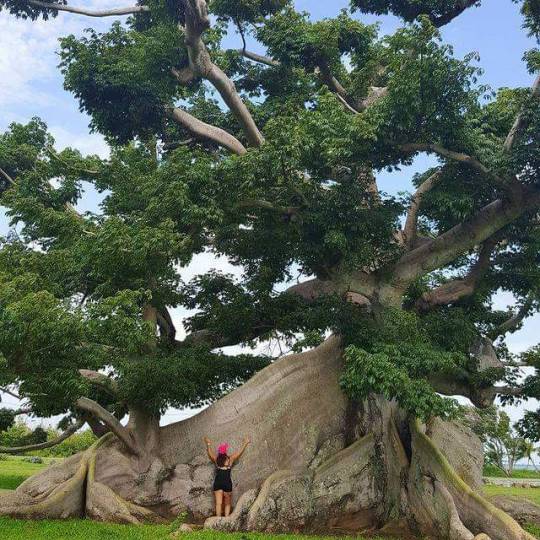
Ceiba Tree (ceiba pentandra) in Vieques, Puerto Rico
150 notes
·
View notes
Video
La Ceiba (Ceiba pentandra (L.) Gaertn.), es uno de los árboles más representativos de las culturas americanas. Su porte majestuoso y la gran variedad de usos le dieron incluso un estado de sagrado en muchas de estas culturas. Los usos tradicionales van desde el aprovechamiento de la madera para la construcción de casas y botes, entre otras; hasta su uso en medicina tradicional para el tratamiento de heridas, dolor de muelas y quemaduras, etc.
#PlantandoIdeasParaInnovar
#decofores
@decofores
0 notes
Text
𝐏𝐞𝐧𝐭𝐚𝐧𝐝𝐫𝐚 - 𝐌𝐨𝐨𝐧𝐜𝐡𝐢𝐥𝐥 (𝟐𝟎𝟐𝟑)
[ ��𝟟 𝕕𝕖 𝕞𝕒𝕣𝕫𝕠 𝕕𝕖 𝟚𝟘𝟚𝟛 · 𝕃𝕦𝕟𝕒 𝕝𝕝𝕖𝕟𝕒 𝕕𝕖 “𝔾𝕦𝕤𝕒𝕟𝕠” 🪱 | 𝔽𝕦𝕝𝕝 “𝕎𝕠𝕣𝕞” 𝕄𝕠𝕠𝕟 ]
ᴇʟ ɴᴏᴅᴏ ᴀsᴄᴇɴᴅᴇɴᴛᴇ ᴇsᴛᴀ́ ᴇɴ 6° ᴛᴀᴜʀᴏ ♉.ʟᴜɴᴀ ᴇɴ ɢʀᴀᴅᴏ 18 ᴅᴇʟ sɪɢɴᴏ ᴠɪʀɢᴏ ♍;ᴛᴀᴍʙɪᴇ́ɴ ᴇɴ ɢʀᴀᴅᴏ 31. ᴅᴇ ʟᴀ ᴄᴏɴsᴛᴇʟᴀᴄɪᴏ́ɴ ʟᴇᴏ ♌.
🌙sᴀ́ʟɪᴅᴀ 18:58ᴘᴜᴇsᴛᴀ 08:01
By atrox.mortem
.
[𝐂𝐚𝐧𝐜𝐢𝐨𝐧𝐞𝐬 𝐚 𝐥𝐚 𝐥𝐮𝐳 𝐝𝐞 𝐥𝐚 𝐥𝐮𝐧𝐚 𝐞𝐧 𝐮𝐧 𝐛𝐨𝐬𝐪𝐮𝐞 𝐝𝐞 𝐬𝐨𝐦𝐛𝐫𝐚𝐬 𝐜𝐡𝐢𝐧𝐞𝐬𝐜𝐚𝐬].
.
No se que origen puede tener el nombre Pentandra, si hace referencia a la Ceiba…
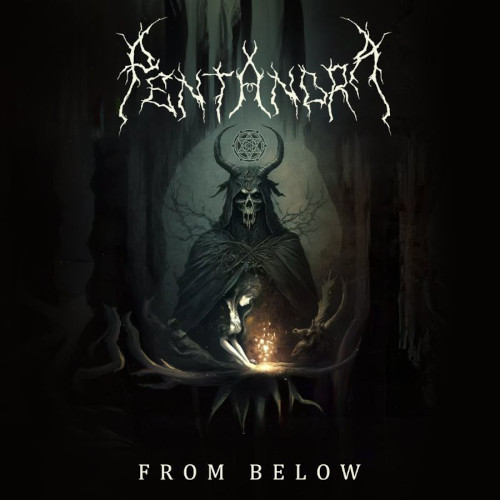
View On WordPress
0 notes

